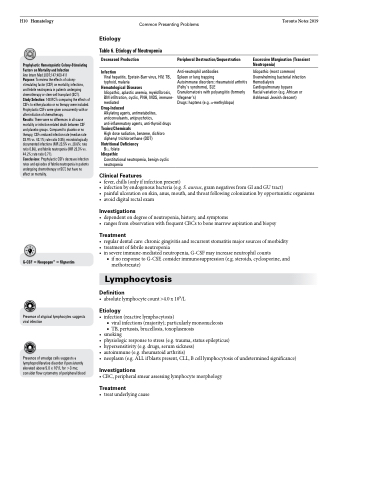Page 550 - TNFlipTest
P. 550
H10 Hematology
Common Presenting Problems
Toronto Notes 2019
Prophylactic Hematopoietic Colony-Stimulating Factors on Mortality and Infection
Ann Intern Med 2007;147:400-411
Purpose: To review the effects of colony- stimulating factor (CSF) on mortality, infections, and febrile neutropenia in patients undergoing chemotherapy or stem-cell transplant (SCT).
Study Selection: 148 RCTs comparing the effects of CSFs to either placebo or no therapy were included. Prophylactic CSFs were given concurrently with or after initiation of chemotherapy.
Etiology
Table 6. Etiology of Neutropenia
Decreased Production
Infection
Viral hepatitis, Epstein-Barr virus, HIV, TB,
typhoid, malaria
Hematological Diseases
Idiopathic, aplastic anemia, myelofibrosis, BM infiltration, cyclic, PNH, MDS, immune- mediated
Drug-Induced
Alkylating agents, antimetabolites, anticonvulsants, antipsychotics, anti-inflammatory agents, anti-thyroid drugs
Toxins/Chemicals
High dose radiation, benzene, dichloro
diphenyl trichloroethane (DDT)
Nutritional Deficiency
B12, folate
Idiopathic
Constitutional neutropenia, benign cyclic neutropenia
Clinical Features
Peripheral Destruction/Sequestration
Anti-neutrophil antibodies
Spleen or lung trapping
Autoimmune disorders: rheumatoid arthritis (Felty’s syndrome), SLE
Granulomatosis with polyangiitis (formerly Wegener’s)
Drugs: haptens (e.g. α-methyldopa)
Excessive Margination (Transient Neutropenia)
Idiopathic (most common) Overwhelming bacterial infection Hemodialysis
Cardiopulmonary bypass
Racial variation (e.g. African or Ashkenazi Jewish descent)
Results: There were no differences in all-cause mortality or infection-related death between CSF and placebo groups. Compared to placebo or no therapy, CSFs reduced infection rate (median rate 38.9% vs. 43.1%; rate ratio 0.85), microbiologically documented infections (MR 23.5% vs. 28.6%; rate ratio 0.86), and febrile neutropenia (MR 25.3% vs. 44.2%; rate ratio 0.71).
Conclusions: Prophylactic CSFs decrease infection rates and episodes of febrile neutropenia in patients undergoing chemotherapy or SCT, but have no effect on mortality.
G-CSF = Neupogen® = filgrastim
Presence of atypical lymphocytes suggests viral infection
Presence of smudge cells suggests a lymphoproliferative disorder if persistently elevated above 5.0 x 109/L for >3 mo; consider flow cytometry of peripheral blood
• fever,chills(onlyifinfectionpresent)
• infectionbyendogenousbacteria(e.g.S.aureus,gramnegativesfromGIandGUtract)
• painfululcerationonskin,anus,mouth,andthroatfollowingcolonizationbyopportunisticorganisms • avoiddigitalrectalexam
Investigations
• dependentondegreeofneutropenia,history,andsymptoms
• rangesfromobservationwithfrequentCBCstobonemarrowaspirationandbiopsy
Treatment
• regulardentalcare:chronicgingivitisandrecurrentstomatitismajorsourcesofmorbidity • treatmentoffebrileneutropenia
• insevereimmune-mediatedneutropenia,G-CSFmayincreaseneutrophilcounts
■ if no response to G-CSF, consider immunosuppression (e.g. steroids, cyclosporine, and methotrexate)
Lymphocytosis
Definition
• absolutelymphocytecount>4.0x109/L
Etiology
• infection(reactivelymphocytosis)
■ viral infections (majority); particularly mononucleosis ■ TB, pertussis, brucellosis, toxoplasmosis
• smoking
• physiologicresponsetostress(e.g.trauma,statusepilepticus)
• hypersensitivity(e.g.drugs,serumsickness)
• autoimmune(e.g.rheumatoidarthritis)
• neoplasm(e.g.ALLifblastspresent,CLL,Bcelllymphocytosisofundeterminedsignificance)
Investigations
• CBC, peripheral smear assessing lymphocyte morphology
Treatment
• treatunderlyingcause


